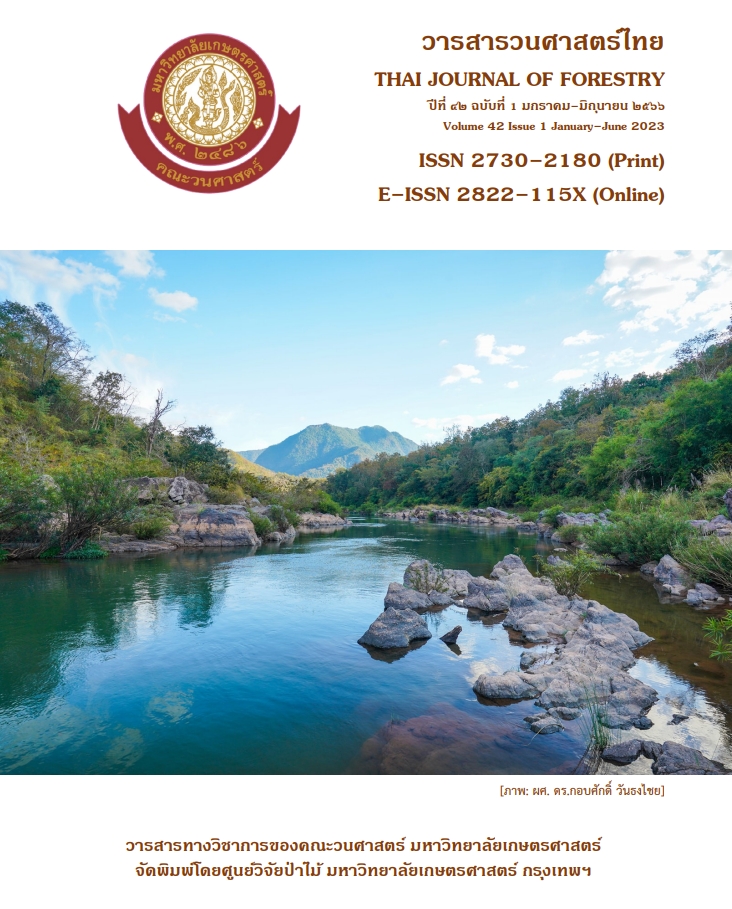การประเมินการปลดปล่อยคาร์บอนจากกิจกรรมของสวนป่าสัก กรณีศึกษา: สวนป่าแม่มาย จังหวัดลำปาง
Main Article Content
บทคัดย่อ
การศึกษาเกี่ยวกับปริมาณการปลดปล่อยคาร์บอนจากกิจกรรมในสวนป่าสักยังมีไม่มากนักในปัจจุบัน โดยงานวิจัยนี้มีวัตถุประสงค์ เพื่อศึกษาปริมาณการปล่อยคาร์บอนจากกิจกรรมทางวนวัฒนวิธีและจากกิจกรรมทำไม้ในพื้นที่สวนป่าแม่มาย จังหวัดลำปาง
โดยทำการเก็บข้อมูลกิจกรรม ผู้วิจัยได้วิเคราะห์ปริมาณการใช้พลังงานและปริมาณการปล่อยคาร์บอนจากข้อมูลที่รวบรวมได้ แปลงค่าปริมาณก๊าซเรือนกระจกให้อยู่ในรูปคาร์บอนเทียบเท่า โดยการคูณด้วยค่าศักยภาพในการทำให้โลกร้อนของก๊าซเรือนกระจกแต่ละชนิด (emission factor)
ผลการศึกษาพบว่าการปลดปล่อยคาร์บอนจากกิจกรรมทางวนวัฒนวิธีของสวนป่าแม่มาย จังหวัดลำปาง จากการวิเคราะห์การปลดปล่อยคาร์บอนตลอดรอบตัดฟัน (30 ปี) พบว่ากิจกรรมทางวนวัฒนวิธีมีการปลดปล่อยคาร์บอนเท่ากับ 49.478 KgCO2eq/rai ทั้งนี้กิจกรรมที่ปลดปล่อยคาร์บอนมากที่สุดในส่วนของวนวัฒนวิธีตลอดระยะเวลาของรอบตัดฟันไม้สัก คือ การกำจัดวัชพืชโดยใช้เครื่องตัดหญ้า รองลงมาคือ การเตรียมพื้นที่โดยรถแทรกเตอร์ตีนตะขาบ กิจกรรมที่ปลดปล่อยคาร์บอนน้อยที่สุด คือ การใส่ปุ๋ยอินทรีย์ และปีที่ปลดปล่อยคาร์บอนมากที่สุดคือ ปีที่ 1 ในขณะที่กิจกรรมการทำไม้มีปริมาณการปลดปล่อยคาร์บอนรวมทั้งหมดเท่ากับ 3.470 KgCO2eq/m3 โดยกิจกรรมที่มีการปลดปล่อยคาร์บอนมากที่สุดคือ การชักลากไม้ด้วยสกิดเดอร์ มีค่าเท่ากับ 1.619 KgCO2eq/m3 และกิจกรรมที่มีการปลดปล่อยคาร์บอนน้อยที่สุดคือ การตัดทอน มีค่าเท่ากับ 0.153 KgCO2eq/m3 ดังนั้นนโยบายสวนป่าจึงควรมีการวางแผนการดำเนินงาน วิเคราะห์ปัจจัยแวดล้อมก่อนการปลูก การพัฒนาและซ่อมแซมดูแลเครื่องมือให้มีประสิทธิภาพอยู่เสมอ หรือการใช้เครื่องมือที่ปลดปล่อยคาร์บอนต่ำทดแทนเครื่องมือเดิม เพื่อเป็นแนวทางในการลดการปลดปล่อยคาร์บอน การบริหารจัดการสวนป่าโดยการนำเทคโนโลยีสมัยใหม่มาประยุกต์ใช้เพื่อช่วยลดปริมาณการปลดปล่อยคาร์บอน การเลือกใช้เครื่องจักรกลให้เหมาะกับสภาพพื้นที่และระยะทาง
Downloads
Article Details

อนุญาตภายใต้เงื่อนไข Creative Commons Attribution-NonCommercial-NoDerivatives 4.0 International License.
ข้าพเจ้าและผู้เขียนร่วม (ถ้ามี) ขอรับรองว่า ต้นฉบับที่เสนอมานี้ยังไม่เคยได้รับการตีพิมพ์และไม่ได้อยู่ในระหว่างกระบวนการพิจารณาตีพิมพ์ลงในวารสารหรือสิ่งตีพิมพ์อื่นใด ข้าพเจ้าและผู้เขียนร่วม (ถ้ามี) ยอมรับหลักเกณฑ์และเงื่อนไขการพิจารณาต้นฉบับ ทั้งยินยอมให้กองบรรณาธิการมีสิทธิ์พิจารณาและตรวจแก้ต้นฉบับได้ตามที่เห็นสมควร พร้อมนี้ขอมอบลิขสิทธิ์ผลงานที่ได้รับการตีพิมพ์ให้แก่วารสารวนศาสตร์ คณะวนศาสตร์ มหาวิทยาลัยเกษตรศาสตร์ กรณีมีการฟ้องร้องเรื่องการละเมิดลิขสิทธิ์เกี่ยวกับภาพ กราฟ ข้อความส่วนใดส่วนหนึ่ง หรือ ข้อคิดเห็นที่ปรากฏในผลงาน ให้เป็นความรับผิดชอบของข้าพเจ้าและผู้เขียนร่วม (ถ้ามี) แต่เพียงฝ่ายเดียว และหากข้าพเจ้าและผู้เขียนร่วม (ถ้ามี) ประสงค์ถอนบทความในระหว่างกระบวนการพิจารณาของทางวารสาร ข้าพเจ้าและผู้เขียนร่วม (ถ้ามี) ยินดีรับผิดชอบค่าใช้จ่ายทั้งหมดที่เกิดขึ้นในกระบวนการพิจารณาบทความนั้น”
เอกสารอ้างอิง
Brown, S., Casarim, F., Grimland, S., Pearson, T. 2011. Carbon Impacts from Selective Logging of Forests in Berau, East Kalimantan, Indonesia. https://winrock.org/wp-content/uploads/2016/03/Winrock_FINAL_logging_report_TNC_06-9-2011.pdf, 10 February 2022
Forest Industry Organization. 2018. Sustainable Forest Management. http://www.northfio.com/web/information/maesaroy61.pdf, 24 September 2022 (in Thai)
Jenssen, K.T., Kongshaug, G. 2003. Energy consumption and greenhouse gas emissions in fertilizer production. IFS (The International Fertiliser Society) Proceedings No:509. IFS, York, UK.
Tangmitcharoen, S. 2020. Economic Forest Plantation. https://shorturl.asia/cak4m, 24 April 2022 (in Thai)
Thailand Greenhouse Gas Management Organization. 2022. Carbon Emission. http://thaicarbonlabel.tgo.or.th/admin/uploadfiles/emission/ts_af09c20f4f.pdf, 6 March 2022 (in Thai)


